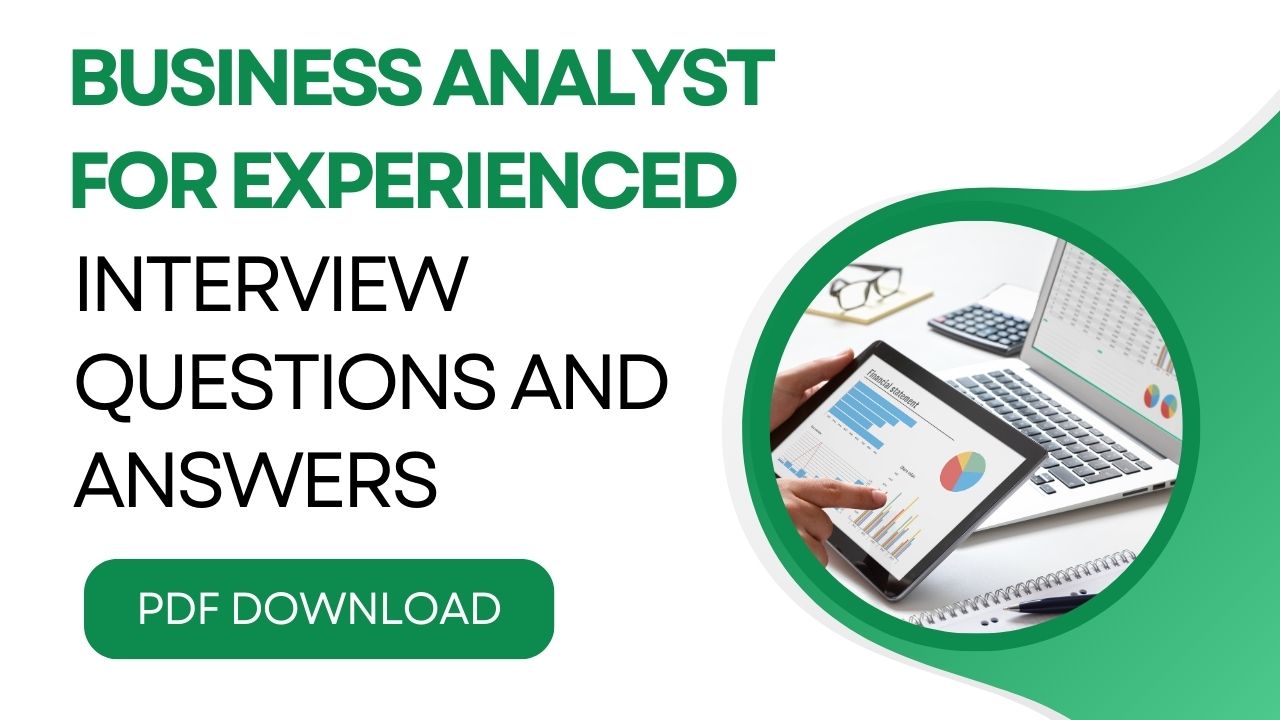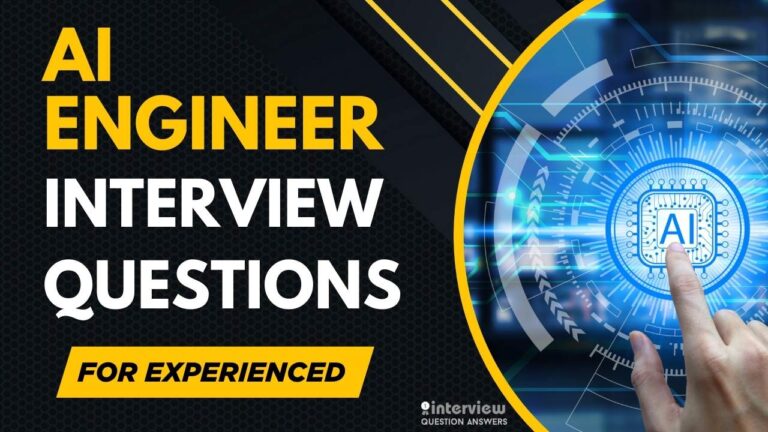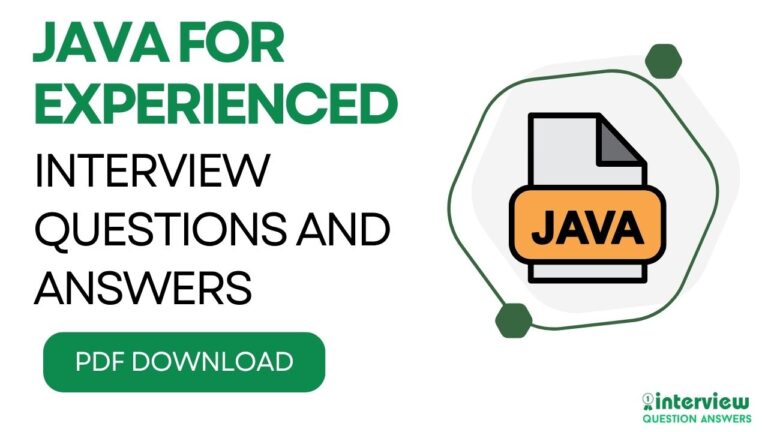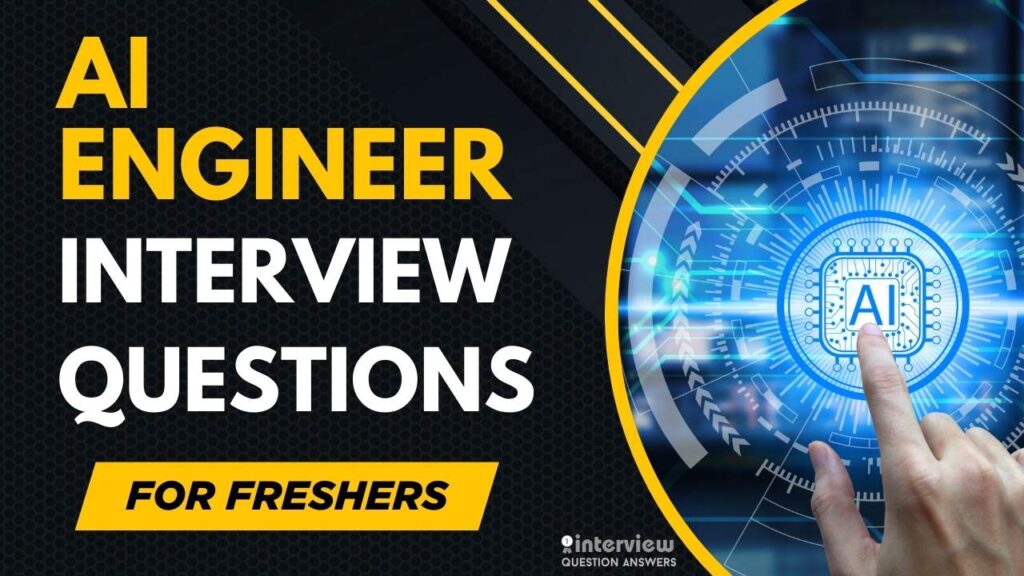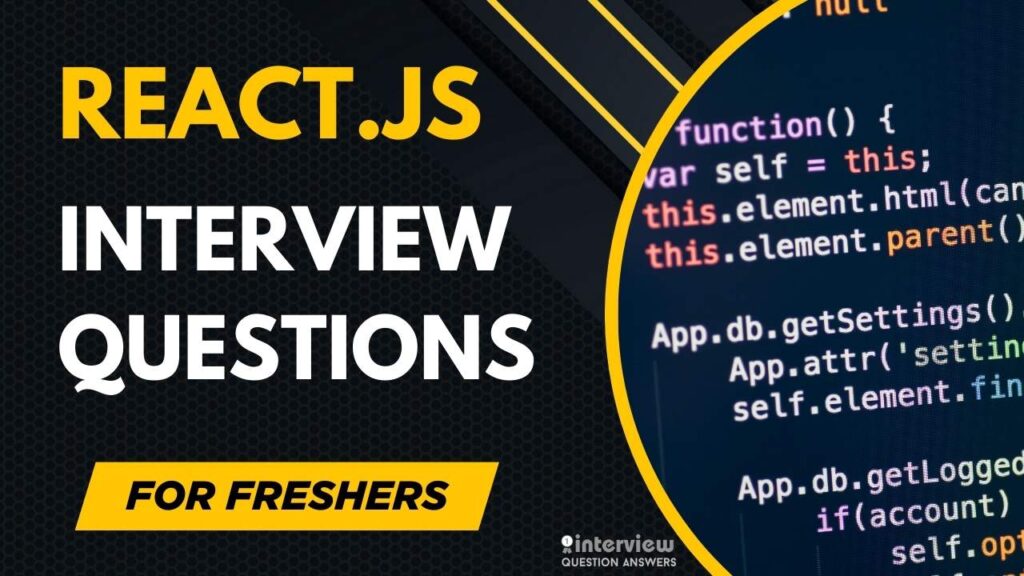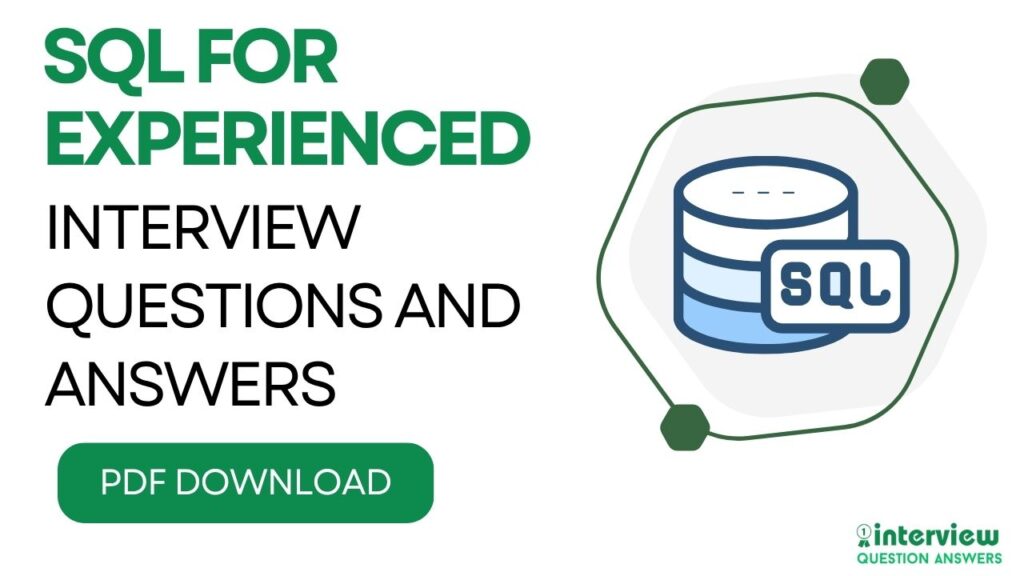Business Analyst Interview Questions for Experienced 2025
Preparing for a senior business analyst role requires more than just foundational knowledge, it demands a deep understanding of strategic analysis, stakeholder management, data-driven decision-making, and process optimization. This Business Analyst Interview Questions guide features the most relevant and challenging interview questions for experienced business analysts, reflecting the latest industry trends and expectations.
From advanced data modeling and Agile methodologies to business intelligence tools, requirement elicitation techniques, and digital transformation strategies, this resource covers the key areas employers focus on when hiring seasoned professionals. Each Business Analyst Interview question is designed to assess your analytical thinking, problem-solving skills, and ability to drive business value.
Business Analyst Interview Questions for Experienced guide will help you sharpen your expertise, anticipate tough scenarios, and confidently articulate your experience. Equip yourself with the insights needed to stand out in competitive interviews and secure your next career milestone.
You can also check our another similer guide here: Business Analyst Interview Questions PDF
Table of Contents
Business Analyst Interview Questions for 2 Year Experience
Que 1. How do you handle changing requirements during a project sprint in an Agile environment?
Answer: In an Agile environment, handle changing requirements by prioritizing them in the product backlog, discussing impacts during sprint planning or daily stand-ups, and using change request processes to assess scope, timeline, and resources. For 2 years of experience, collaborating with the product owner to refine user stories and ensure minimal disruption while maintaining sprint goals is key.
Que 2. What techniques do you use to elicit requirements from stakeholders who are not tech-savvy?
Answer: Techniques include conducting workshops with visual aids like flowcharts or prototypes, using simple language in interviews, and employing tools like mind maps or storyboards to illustrate concepts. For 2 years of experience, following up with summarized notes and iterative feedback sessions ensures alignment and clarity.
Que 3. How do you create and maintain a requirements traceability matrix in a mid-sized project?
Answer:
| Column | Description |
|---|---|
| Requirement ID | Unique identifier for each requirement |
| Source | Stakeholder or document origin |
| Test Case ID | Linked test cases for validation |
| Status | Current state (e.g., approved, implemented) |
Maintain it in tools like Excel or JIRA by updating during reviews and change requests. For 2 years of experience, regular audits prevent gaps in coverage.
Que 4. Describe a situation where you identified a gap in requirements and how you resolved it.
Answer: In a past project, I noticed a gap in data security requirements during a review. I resolved it by organizing a focused stakeholder meeting, documenting the missing elements in an updated BRD, and incorporating them into the development plan, ensuring compliance without delaying the timeline.
Que 5. What is the difference between a BRD and an SRS, and when do you use each?
Answer: A BRD (Business Requirements Document) outlines high-level business needs and objectives, used early to align stakeholders. An SRS (System Requirements Specification) details technical and functional specs, used for development and testing. For 2 years of experience, BRD guides initial planning, while SRS drives implementation.
Que 6. How do you use tools like JIRA or Trello for requirement management?
Answer: Use JIRA or Trello to create epics for high-level requirements, break them into user stories, assign priorities, and track status with workflows. For 2 years of experience, integrating with Confluence for documentation and using labels for traceability enhances efficiency.
Que 7. What steps do you take to validate requirements with stakeholders?
Answer: Steps include reviewing drafts in meetings, using prototypes for feedback, conducting walkthroughs, and prioritizing changes based on impact. For 2 years of experience, incorporating sign-off processes ensures accountability and reduces revisions later.
Que 8. How do you apply the Kano model in prioritizing features?
Answer: The Kano model categorizes features as basic (must-have), performance (satisfiers), and delighters (exciters). Prioritize basics first, then performance, and add delighters if resources allow. For 2 years of experience, surveying stakeholders helps classify features accurately.
Example:
**Kano Categories**
- Basic: User login
- Performance: Fast search
- Delighter: Personalized recommendationsQue 9. Describe how you would conduct a cost-benefit analysis for a proposed feature.
Answer: Gather costs (development, maintenance) and benefits (revenue increase, efficiency gains), quantify them, calculate ROI, and present findings to stakeholders. For 2 years of experience, using tools like Excel for projections and sensitivity analysis ensures robust evaluations.
Que 10. What is your approach to managing stakeholder expectations in a project with tight deadlines?
Answer: Set realistic expectations early through clear communication, regular updates via status reports, and transparent risk discussions. For 2 years of experience, negotiating scope adjustments and focusing on MVP delivery helps maintain trust and meet deadlines.
Business Analyst Interview Questions for 3 Year Experience
Que 11. How do you ensure alignment between business objectives and technical requirements in a project?
Answer: Ensure alignment by translating business objectives into clear, measurable requirements during stakeholder workshops, documenting them in a BRD, and validating with technical teams via SRS reviews. For 3 years of experience, regular syncs with stakeholders and developers using tools like JIRA, along with iterative feedback loops, maintain consistency and address misalignments early.
Que 12. What approach do you take to resolve conflicts between stakeholders with differing priorities?
Answer: Facilitate a prioritization workshop using techniques like MoSCoW or weighted scoring to rank requirements based on business value and feasibility. Document decisions and trade-offs in a shared platform like Confluence. For 3 years of experience, mediating with data-driven insights and aligning on project goals ensures resolution while maintaining stakeholder trust.
Que 13. How do you use business process modeling to improve operational efficiency?
Answer: Map current (“as-is”) processes using BPMN or flowcharts, identify bottlenecks, and propose optimized (“to-be”) processes. Validate improvements with stakeholders and monitor KPIs post-implementation. For 3 years of experience, tools like Bizagi or Lucidchart and stakeholder collaboration drive measurable efficiency gains.
Example:
**As-Is Process**: Manual order entry → Approval → Fulfillment
**To-Be Process**: Automated entry → Real-time approval → FulfillmentQue 14. What is your experience with facilitating Agile ceremonies as a Business Analyst?
Answer: As a BA, facilitate ceremonies like sprint planning, backlog grooming, and retrospectives by clarifying requirements, refining user stories, and ensuring stakeholder input. For 3 years of experience, preparing acceptance criteria and moderating discussions in ceremonies using JIRA or Trello enhances team collaboration and sprint success.
Que 15. How do you use data analysis to support business decisions in a project?
Answer: Analyze data using tools like Excel, SQL, or Power BI to identify trends, validate assumptions, or quantify benefits. Present findings in reports or dashboards to support stakeholder decisions. For 3 years of experience, combining data insights with business context ensures actionable recommendations.
Que 16. What is the role of a BA in managing technical debt during a project?
Answer: A BA identifies technical debt by documenting trade-offs in requirements (e.g., quick fixes vs. scalable solutions) and prioritizes debt resolution with the team. For 3 years of experience, tracking debt in JIRA and advocating for refactoring during sprint planning balances short-term delivery with long-term quality.
Que 17. How do you create effective acceptance criteria for user stories?
Answer: Write clear, testable acceptance criteria using the Given-When-Then format, ensuring they align with user needs and are verifiable. For 3 years of experience, collaborating with QA teams and stakeholders in tools like JIRA ensures criteria are robust and reduce ambiguity.
Example:
**User Story**: As a user, I want to log in.
**Acceptance Criteria**:
- Given valid credentials, when I submit, then I access the dashboard.
- Given invalid credentials, when I submit, then an error is displayed.Que 18. What is your approach to conducting a risk assessment for a project?
Answer: Identify risks through stakeholder interviews and SWOT analysis, assess their likelihood and impact, and document in a risk register. Propose mitigation strategies and monitor risks using tools like Excel or JIRA. For 3 years of experience, proactive risk tracking and stakeholder communication minimize project disruptions.
Que 19. How do you use prototyping to validate requirements with stakeholders?
Answer: Create low-fidelity (e.g., wireframes) or high-fidelity prototypes using tools like Figma or Balsamiq to visualize functionality. Review prototypes in workshops to gather feedback and refine requirements. For 3 years of experience, iterative prototyping ensures stakeholder alignment and reduces rework.
Que 20. How do you support the testing phase as a Business Analyst?
Answer: Support testing by defining test scenarios based on requirements, assisting QA with test case creation, and facilitating UAT with stakeholders. For 3 years of experience, tracking defects in JIRA and ensuring traceability to requirements enhances testing accuracy and project quality.
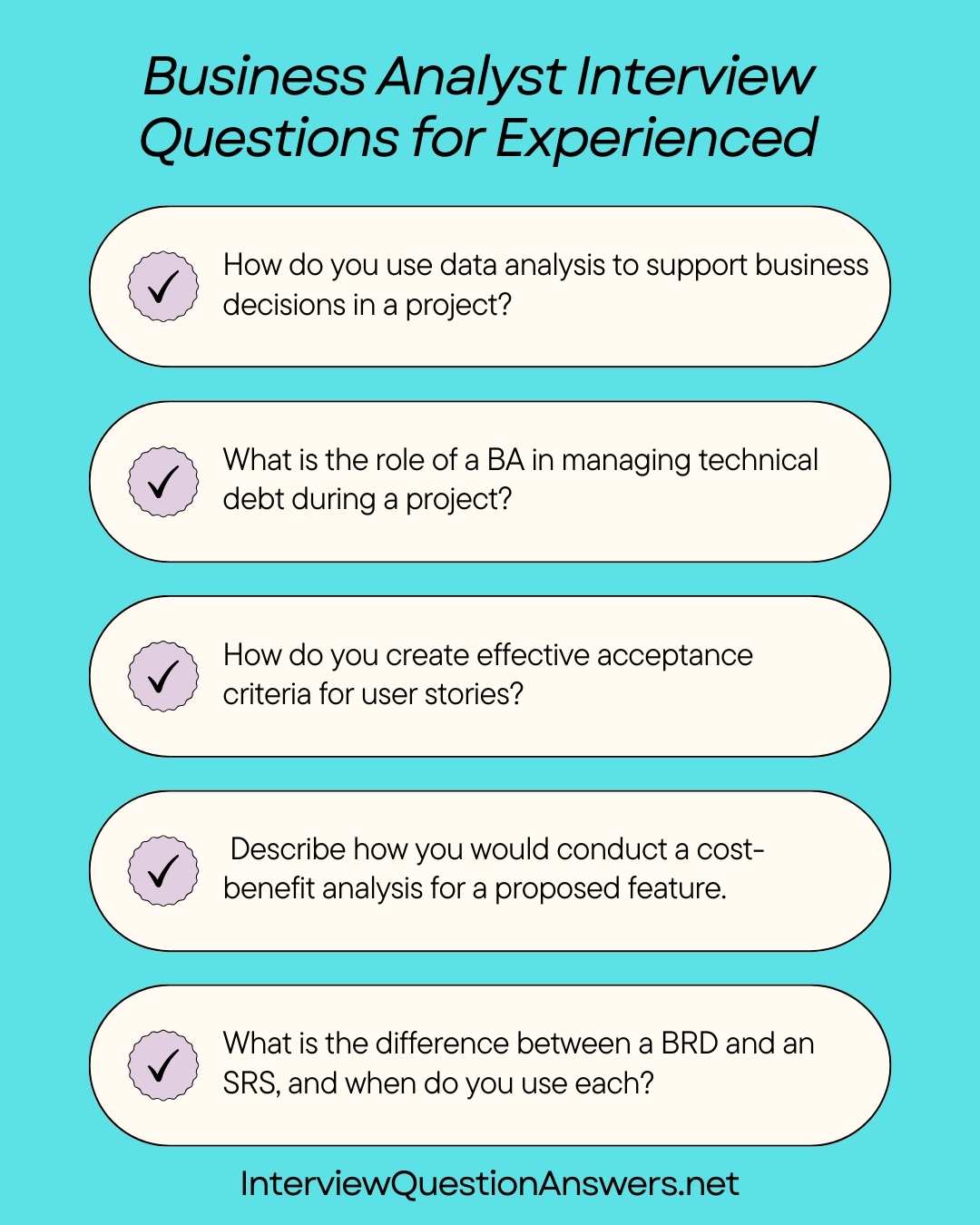
Business Analyst Interview Questions for 5 Year Experience
Que 21. How do you ensure effective communication between cross-functional teams in a complex project?
Answer: Facilitate communication by organizing regular sync meetings, using collaboration tools like Slack or Microsoft Teams, and maintaining a centralized repository like Confluence for requirements and updates. For 5 years of experience, translating technical jargon into business terms and using visual aids like process flows or dashboards ensures alignment across diverse teams.
Que 22. What is your approach to managing requirements in a project with multiple stakeholders and conflicting priorities?
Answer: Use prioritization frameworks like MoSCoW or Weighted Shortest Job First (WSJF), conduct stakeholder workshops to align on objectives, and document decisions in a shared BRD or JIRA. For 5 years of experience, mediating conflicts with data-driven insights and maintaining a traceability matrix ensures transparency and consensus.
Que 23. How do you leverage data analytics to drive business process improvements?
Answer: Analyze data using tools like SQL, Power BI, or Tableau to identify inefficiencies, bottlenecks, or trends in business processes. Propose data-driven solutions and validate with stakeholders via KPI tracking. For 5 years of experience, integrating predictive analytics and presenting actionable insights in reports enhances process optimization.
Example:
**Process Improvement Example**
- Current: Manual data entry takes 5 hours/week.
- Proposed: Automate with API, reducing to 1 hour/week.
- KPI: Time saved, error rate reduction.Que 24. How do you handle a situation where a project is at risk of missing deadlines due to unclear requirements?
Answer: Identify unclear requirements through reviews, conduct rapid elicitation sessions with stakeholders, and prioritize critical features for an MVP. Update the SRS and communicate impacts to the team. For 5 years of experience, using Agile techniques like time-boxed sprints and regular backlog refinement mitigates delays effectively.
Que 25. What is the role of a Business Analyst in implementing a new software system?
Answer: A BA defines requirements, maps current and future processes, facilitates vendor selection, supports data migration, and coordinates UAT. For 5 years of experience, ensuring seamless integration by creating detailed workflows and training materials in tools like Confluence is critical for successful adoption.
Que 26. How do you use a decision table to resolve complex business rules?
Answer: A decision table organizes business rules by listing conditions, actions, and outcomes in a tabular format, clarifying complex logic. For 5 years of experience, creating tables in Excel or Visio and validating with stakeholders ensures accurate implementation by developers.
Example:
| Condition: Age | Condition: Member | Action: Discount |
|----------------|------------------|------------------|
| >= 18 | Yes | 20% |
| < 18 | No | 0% |Que 27. How do you support change management during a system implementation?
Answer: Support change management by assessing impacts, creating a change plan, training users, and communicating benefits via presentations or documentation. For 5 years of experience, using frameworks like ADKAR and tracking adoption metrics in tools like JIRA ensures smooth transitions.
Que 28. What is your experience with integrating APIs into business processes?
Answer: Document API requirements, map data flows, and collaborate with developers to integrate APIs using tools like Postman for testing. For 5 years of experience, ensuring API security (e.g., OAuth) and monitoring performance with logs or dashboards optimizes business workflows.
Que 29. How do you measure the success of a project as a Business Analyst?
Answer: Measure success by tracking KPIs like user adoption, process efficiency, or ROI, aligned with business objectives. Use stakeholder feedback and post-implementation reviews to validate outcomes. For 5 years of experience, defining measurable metrics early in tools like Power BI ensures clear success criteria.
Que 30. What is your approach to conducting a post-implementation review?
Answer: Conduct a post-implementation review by gathering stakeholder feedback, analyzing KPIs, and comparing outcomes to objectives. Document lessons learned in Confluence and recommend improvements. For 5 years of experience, facilitating a structured review meeting and tracking action items in JIRA drives continuous improvement.
Business Analyst Interview Questions for 7 Year Experience
10 Business Analyst Interview Questions and Answers for 7 Years Experience
Que 31. How do you integrate advanced data analytics techniques into business process reengineering efforts?
Answer: Integrating advanced data analytics into business process reengineering (BPR) involves leveraging tools like machine learning models (e.g., predictive analytics in Python or R) to identify inefficiencies in “as-is” processes. For 7 years of experience, start by mapping processes with BPMN, then apply data mining to historical data for pattern recognition, such as bottleneck detection using regression analysis.
Propose “to-be” processes with AI-driven optimizations, like automating decision points with decision trees. Validate with simulations in tools like Arena or AnyLogic, and measure ROI through KPIs like cycle time reduction. Challenges include data privacy compliance (GDPR) and stakeholder buy-in, addressed via pilot programs.
Que 32. What strategies do you employ to manage stakeholder expectations in a multi-vendor project environment?
Answer: In multi-vendor projects, manage expectations by establishing a unified communication framework, such as a shared RACI matrix and centralized dashboard in tools like Microsoft Project or Asana. For 7 years of experience, conduct joint requirement workshops to align on SLAs, use escalation protocols for conflicts, and implement regular performance reviews with vendors. Monitor progress via integrated KPIs, and mitigate risks with contingency plans. Success relies on transparent reporting and fostering collaborative relationships through contract incentives.
- Strategy 1: Define clear SLAs and KPIs upfront.
- Strategy 2: Use agile ceremonies for cross-vendor alignment.
- Strategy 3: Implement a governance board for dispute resolution.
Que 33. How do you use enterprise architecture frameworks like TOGAF to guide business analysis in large organizations?
Answer: TOGAF (The Open Group Architecture Framework) guides business analysis by providing a structured approach to align IT with business strategy. For 7 years of experience, apply the ADM (Architecture Development Method) phases: start with vision definition, then model business architecture (processes, capabilities), and integrate with information systems.
Use artifacts like capability maps and gap analysis to identify improvements. Challenges include resistance to change, addressed by stakeholder engagement and phased implementation. Benefits include scalable solutions and reduced redundancy.
Que 34. What is your approach to conducting a comprehensive feasibility study for a digital transformation initiative?
Answer: Conduct a feasibility study by assessing technical (e.g., system compatibility), economic (cost-benefit analysis), operational (process impact), legal (compliance), and schedule (timeline) aspects. For 7 years of experience, gather data through SWOT/PESTLE analyses, stakeholder surveys, and pilot testing. Use tools like Excel for financial modeling and Gantt charts for timelines.
Present findings in a report with recommendations, including risk mitigation. Ensure alignment with organizational strategy by involving C-level executives.
| Feasibility Aspect | Key Considerations |
|---|---|
| Technical | Compatibility with existing systems |
| Economic | ROI, NPV calculations |
| Operational | Training needs, process disruptions |
Que 35. How do you leverage AI and machine learning in requirement elicitation and analysis?
Answer: Leverage AI by using natural language processing (NLP) tools like IBM Watson or Google Cloud Natural Language to analyze stakeholder interviews for sentiment and key themes. For 7 years of experience, apply machine learning for predictive requirement prioritization, such as clustering similar user stories in tools like RapidMiner.
Validate AI outputs with manual reviews to avoid biases, and integrate into agile workflows for dynamic analysis. Benefits include faster insights, but ethical considerations like data bias are critical.
Que 36. What is the role of a Business Analyst in implementing DevOps practices within an organization?
Answer: A BA in DevOps bridges business and operations by defining requirements for CI/CD pipelines, automating processes, and ensuring alignment with business agility goals. For 7 years of experience, collaborate on tool selection (e.g., Jenkins, GitLab), document workflows, and measure metrics like deployment frequency. Facilitate cultural shifts through training and KPI tracking, ensuring seamless integration.
- Role 1: Define automation requirements.
- Role 2: Monitor DevOps metrics for business impact.
- Role 3: Facilitate cross-team collaboration.
Que 37. How do you use value stream mapping to optimize business processes?
Answer: Value stream mapping visualizes the flow of materials and information in a process, identifying waste like delays or overproduction. For 7 years of experience, map current state, calculate lead time and value-added time, then design future state with kaizen bursts for improvements. Use tools like Visio or LeanKit, and validate with stakeholders to achieve lean efficiency.
Que 38. What strategies do you use to manage project risks in a volatile market environment?
Answer: Manage risks by conducting regular risk assessments with tools like Monte Carlo simulations for probability analysis, developing contingency plans, and using agile methodologies for flexibility. For 7 years of experience, integrate real-time market data into risk registers, engage in scenario planning, and monitor leading indicators with dashboards in Power BI to proactively mitigate impacts.
Que 39. How do you incorporate sustainability considerations into business analysis practices?
Answer: Incorporate sustainability by assessing environmental impacts in requirements (e.g., energy-efficient systems), using green KPIs like carbon footprint reduction, and aligning with frameworks like ESG (Environmental, Social, Governance). For 7 years of experience, conduct lifecycle assessments, recommend eco-friendly vendors, and document sustainability metrics in BRDs to support corporate responsibility goals.
Que 40. What is your experience with using blockchain technology in business process analysis?
Answer: Analyze blockchain for processes requiring transparency, like supply chain tracking, by mapping smart contracts to requirements and evaluating benefits like immutability. For 7 years of experience, assess integration challenges (e.g., scalability), prototype in tools like Ethereum, and calculate ROI for decentralized solutions in finance or logistics.
Business Analyst Interview Questions for 10 Year Experience
Que 41. How do you align business analysis practices with an organization’s digital transformation strategy at an enterprise level?
Answer: Align business analysis with digital transformation by integrating enterprise architecture frameworks like TOGAF, mapping digital capabilities to strategic goals, and prioritizing initiatives using portfolio management tools like Planview. For 10 years of experience, conduct capability assessments, define KPIs for digital maturity (e.g., automation adoption rate), and facilitate cross-functional workshops to align stakeholders. Use predictive analytics in tools like Tableau to forecast transformation impacts, ensuring scalability and measurable outcomes while addressing risks like legacy system integration.
Que 42. What is your approach to implementing a data-driven decision-making framework across multiple business units?
Answer: Implement a data-driven framework by establishing a centralized data governance model, defining standardized KPIs, and deploying analytics platforms like Power BI or QlikView. For 10 years of experience, create a data strategy with clear roles (e.g., data stewards), integrate disparate data sources using ETL processes, and train units on data literacy. Challenges like data silos are mitigated through enterprise-wide data lakes and real-time dashboards.
- Define KPIs aligned with business goals.
- Deploy scalable analytics tools.
- Foster a data-driven culture via training.
Que 43. How do you manage stakeholder resistance to adopting new technologies in large-scale projects?
Answer: Manage resistance by conducting change impact assessments, using ADKAR or Kotter’s 8-step model to drive adoption, and creating tailored communication plans. For 10 years of experience, leverage stakeholder mapping to identify influencers, pilot technologies to demonstrate value, and measure adoption metrics with tools like Power BI. Address concerns through iterative feedback loops and executive sponsorship to ensure buy-in.
Que 44. What is your experience with integrating AI-driven process automation into business workflows?
Answer: Integrate AI-driven automation by mapping workflows, identifying automatable tasks (e.g., RPA for repetitive processes), and defining requirements for tools like UiPath or Automation Anywhere. For 10 years of experience, collaborate with data scientists to embed machine learning models (e.g., for predictive maintenance), validate with pilots, and monitor ROI via KPIs like cost savings. Challenges include ethical AI use, addressed through governance frameworks.
Que 45. How do you use advanced risk management techniques, like Monte Carlo simulations, in project planning?
Answer:
| Technique | Purpose | Tool Example |
|---|---|---|
| Monte Carlo Simulation | Quantifies risk probability and impact | @Risk, Excel |
| Sensitivity Analysis | Identifies critical risk factors | Power BI |
| Scenario Planning | Prepares for multiple outcomes | Miro |
For 10 years of experience, run Monte Carlo simulations to model schedule or cost risks, using tools like @Risk to generate probability distributions. Combine with stakeholder workshops to prioritize mitigation strategies, ensuring robust contingency planning.
Que 46. What strategies do you employ to optimize cross-departmental business processes in a global organization?
Answer: Optimize processes by conducting value stream mapping, identifying redundancies, and standardizing workflows across departments using BPMN. For 10 years of experience, implement ERP integrations (e.g., SAP), leverage process mining tools like Celonis, and establish global governance councils. Monitor improvements with KPIs like process cycle time, addressing cultural differences through localized training.
- Map global processes with BPMN.
- Use process mining for data-driven insights.
- Align via cross-departmental governance.
Que 47. How do you incorporate regulatory compliance (e.g., GDPR, HIPAA) into business analysis for system implementations?
Answer: Incorporate compliance by mapping regulatory requirements to system features, embedding controls in the SRS, and conducting compliance audits. For 10 years of experience, collaborate with legal teams, use frameworks like COBIT, and implement automated compliance checks with tools like OneTrust. Ensure traceability to regulations and train stakeholders on compliance impacts to avoid penalties.
Que 48. What is your approach to leading a business case development for a multimillion-dollar project?
Answer: Lead business case development by conducting stakeholder needs analysis, performing cost-benefit analysis with NPV/IRR calculations, and aligning with strategic objectives. For 10 years of experience, use Monte Carlo simulations for risk-adjusted ROI, present scenarios in PowerPoint, and secure executive approval through iterative reviews. Address uncertainties by modeling multiple financial outcomes in Excel.
Que 49. How do you leverage enterprise data lakes to enhance business analysis outcomes?
Answer: Leverage data lakes by defining data requirements for analytics, integrating sources via ETL pipelines (e.g., Apache NiFi), and querying with tools like Snowflake or SQL. For 10 years of experience, design data models for business insights, implement governance for quality, and create dashboards in Tableau to drive decisions. Challenges like data consistency are mitigated through metadata management.
Que 50. What is your experience with facilitating large-scale organizational change through business analysis?
Answer: Facilitate change by applying frameworks like Prosci ADKAR, conducting impact assessments, and developing training programs. For 10 years of experience, lead change by creating stakeholder engagement plans, measuring adoption with metrics like user satisfaction, and using tools like JIRA for tracking. Success requires aligning change initiatives with strategic goals and sustaining momentum through continuous feedback.

